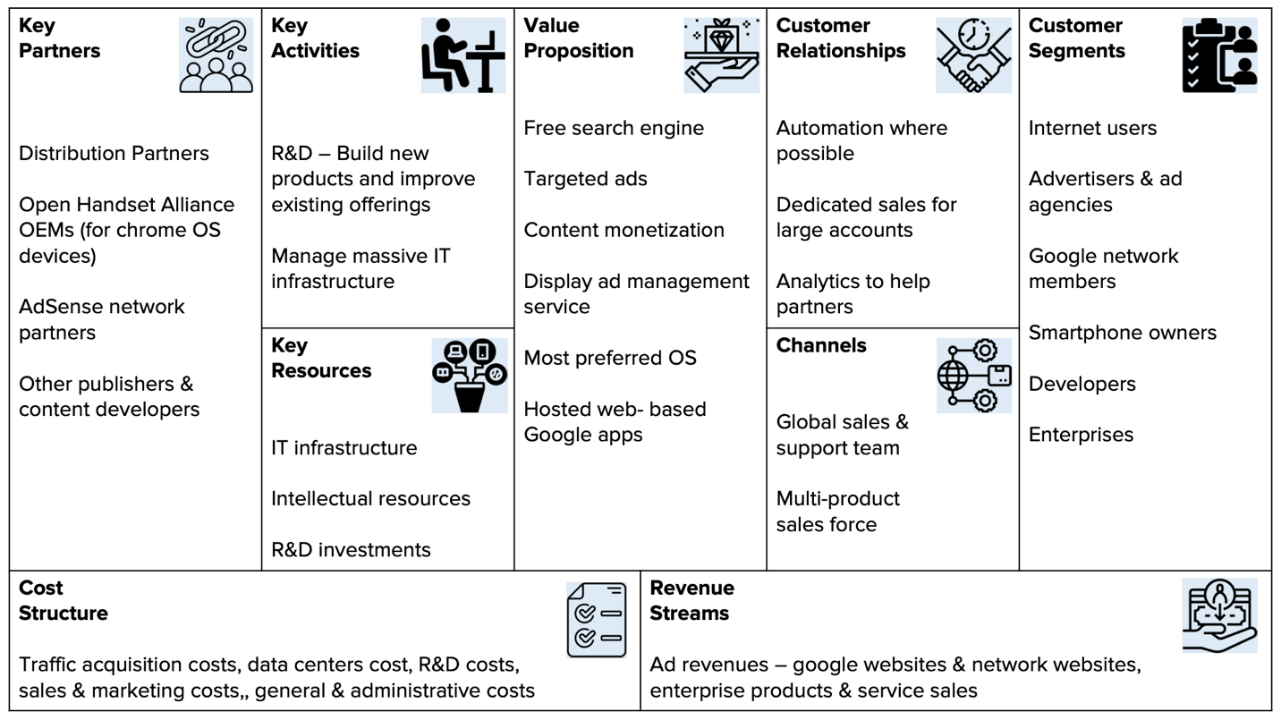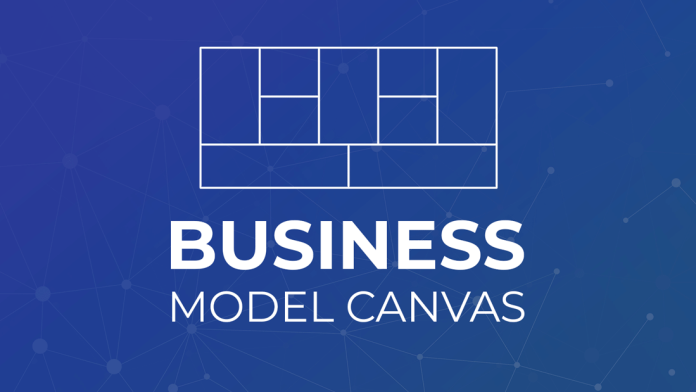The four key components of Strategy Analysis are principles, practices, techniques, and skills. They play an essential role in identifying and validating the organization’s strategic needs, defining suitable solution approach(es) and solution(s), and planning, monitoring, and engaging stakeholders to achieve the organization’s strategic objectives. Techniques describe a step-by-step approach to conducting Strategic Analysis activities.
Need to develop new business models and document existing ones to align business activities by illustrating potential trade-offs? Here is a Strategy Analysis technique to achieve that. This blog will look at a technique called Business Model Canvas with examples.
Alexander Osterwalder and Yves Pigneur first proposed the Business Model Canvas in their book Business Model Generation: A Handbook for Visionaries, Game Changers, and Challengers in 2010. The Business Model Canvas is a strategic management and lean startup template for developing new or documenting existing business models. It is a visual chart with elements describing a firm’s value proposition, infrastructure, customers, and finances.
Read Also: Business Brokers in Sarasota
The Business Model Canvas is an adaptation of the traditional Business Model and is used to create a visual overview of all the key elements of a business, including the customer segments, value proposition, channels, customer relationships, revenue streams, key resources, key activities, key partnerships, and cost structure. This helps quickly identify areas where a business can be improved or new opportunities may exist.
The Business Model Canvas has been widely adopted by entrepreneurs, business strategists, and corporate executives. It is used to develop and improve business models, build strategies, analyze competition, and position products in the market. It is also used to present business plans, evaluate new ventures, and develop innovative ideas. The Business Model Canvas is a powerful tool for understanding a business’s current state and creating a plan for the future.
Purpose
Refers to 9 building blocks describing how an organization delivers value.
As a diagnostic tool, use the canvas element as a lens into the current state of business, especially with relative amounts of energy, time, and resources currently invested in various areas.
As a planning and monitoring tool, use canvas to understand inter-dependencies and priorities among groups and initiatives. In this capacity, the canvas can be used to view where an enterprise is investing, where a particular initiative fits, and any related initiatives.

Figure 14: Sample Business Model Canvas
Description
The 9 building blocks are:
Key partnerships: Sharing proprietary information and technologies can lead to formalized relationships such as mergers and acquisitions.
Key activities: Key activities are critical to creating, delivering, and maintaining value. 3 types of activities are:
Value-add: Characteristics, features, and activities for which the customer is willing to pay.
Non-value-add: Aspects and activities for which the customer is not willing to pay.
Characteristics to be included in Business non-value-add (those which meet regulatory needs or costs associated with doing business) for which the customer is not willing to pay.
Key resources: Assets needed to execute a business model. Types:
Physical: Applications, locations, and machines.
Financial: Cash and lines of credit.
Intellectual: Proprietary knowledge, patents and copyrights, customer databases, and brands.
Human: People.
Value proposition: What a customer is willing to pay to have their needs met.
Customer relationships: Deals with customer acquisition and retention.
Channels: Different ways to interact with and deliver value to their customers. It can be communication-oriented (e.g., Marketing channel), delivery-oriented (e.g., Distribution channel), sales, and partnering channels.
Channels are used to:
- Raise awareness about offerings.
- Help customers evaluate value propositions.
- Purchase of goods or services.
- Provide support.
Customer segments: Customers with common needs and attributes. Helps to address customer needs effectively and efficiently.
Cost structure: Every enterprise entity, product, or activity has an associated cost. Understand types of business models, differences in types of costs and their impact, and where the enterprise is focusing its efforts to reduce costs.
Revenue streams: A way or method by which revenue comes into an enterprise from each customer segment. 2 basic ways of organizational Revenues:
One-time purchase of a good or service.
- Sales: Grants ownership rights to customers for the product.
- One-time license fees.
Recurring revenue from periodic payments for a good, service, or ongoing support.
- Recurring licensing or subscription fees: The customer pays for the right to access a particular asset as a recurring cost.
- Transaction or Usage fees: Customer pays each time they use a good or service.
- Lending, Renting, or Leasing: Customers can use an asset temporarily.
Usage consideration
It’s a simple and easy-to-understand model that helps understand and optimize business models.
Advantages of Business Model Canvas as a strategy analysis technique
- Improves Communication: The Business Model Canvas allows you to visually present your business model, which makes it easier to explain and discuss with others.
- Encourages Creativity: The structure of the Business Model Canvas encourages creative thinking, as it requires you to consider different aspects of your business model and how they interact.
- Facilitates Collaboration: The Business Model Canvas allows multiple stakeholders to work together to create and refine a business model.
- Helps Identify Weaknesses: The Business Model Canvas helps you to identify the weak points in your business model, which can then be addressed and improved.
- Decreases Risk: By thoroughly analyzing your business model, you’re able to identify potential risks and take steps to mitigate them.
- Increases Efficiency: By creating a visual representation of your business model, you’re able to quickly identify areas of efficiency and areas where improvements could be made.
Weaknesses of Business Model Canvas as a strategy analysis technique
- A comprehensive analysis of the overall strategy is not provided. The Business Model Canvas does not allow for a deep dive into the strategy and does not provide an in-depth understanding of the competitive environment or other external factors that can impact the success of the business.
- It does not support long-term planning. The Business Model Canvas is a snapshot of the current business environment and does not provide a view of future opportunities or potential risks.
- It does not provide a holistic view of the business. The canvas only looks at the business model and does not include other aspects of the business, such as operations, marketing, finance, and human resources.
- It is too simplified. The Business Model Canvas is a simplified representation of the business, which may not provide enough detail to fully understand the business.
- It is not suitable for every business. For example, the Business Model Canvas may not be suitable for complex businesses requiring detailed analysis.
Relationship of Business Model Canvas with other strategy analysis techniques
The Business Model Canvas is a well-known strategy analysis technique that visually represents a company’s strategy. It can be used in conjunction with other analysis techniques, such as SWOT Analysis, Porter’s Five Forces Analysis, and Value Chain Analysis, to provide a comprehensive overview of a firm’s strategy. Additionally, the Business Model Canvas can identify areas where a company’s strategy could be improved and develop new strategies. It can also be used to compare different companies’ strategies and determine which strategies best suit a particular business. By combining the Business Model Canvas with other analysis techniques, businesses can better understand their current strategy and make informed decisions regarding their future.
Future of Business Model Canvas as a strategy analysis technique
The Business Model Canvas (BMC) will remain a popular strategy analysis technique for the foreseeable future because of its versatility and ease of use. As the business world continues to evolve and become increasingly complex, the BMC will remain an effective tool for strategists to use to quickly and easily assess a company’s current business model and strategize for the future. The BMC’s ability to be adapted to different industries, organizations, and strategies makes it a valuable tool for businesses of all sizes and types. As companies continue to explore new business models, the BMC will remain a useful and relevant tool for helping strategists understand the complexities of their business models and devise effective strategies for future success.
About Adaptive US
This blog is written by Adaptive US. It is among the world’s Most Trusted IIBA Certifications training organizations. We have helped 1500+ students complete IIBA certifications. We are one of the leading IIBA certifications training providers in the last 3 years in a row, 2020, 2021, and 2022. Adaptive US provides success guaranteed CBAP, CCBA, ECBA, BA Bootcamp, AAC, CBDA, CCA, CPOA online, virtual and on-premise training, question banks, study guides, simulators, flashcards, audio-books, digital learning packs and many more across the globe. For more Information, kindly visit our website: https://www.adaptiveus.com



